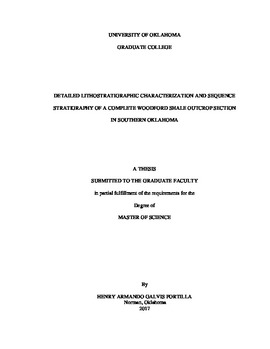| dc.description.abstract | This work presents a detailed rock-based and stratigraphic documentation of an unpublished and recently discovered Woodford Shale outcrop in the south flank of the Arbuckle Mountains (southern Oklahoma). The exposed section comprises the entire Woodford Shale (320 ft), as well as its basal and overlying formational contacts with the Hunton Group and Sycamore Limestone respectively.
The basal contact is unconformable, and records the shallower carbonate deposits of the heavily karstified and bioturbated Hunton Group, sharply capped by the lowermost Woodford, which records the onset of a transgressive phase, represented by non-organic greenish/brown claystones and coarse grained glauconitic sandstones, that fines upward into organic-rich shales of the lower Woodford.
The upper contact between the Woodford Shale and the Sycamore Limestone is transitional, and suggests a general upward increase in paleo-oxygenation and terrigenous input, represented by non-organic, bioturbated greenish/grey siltstones that grades into marlstones of the early Mississippian.
Within the Woodford Shale strata, seven main lithofacies were recognized honoring textural, rock fabric, organic richness and mineral composition (siliceous, argillaceous or dolomitic). Vertical stacking of these lithofacies, tied with outcrop Gamma-ray profiles and elemental chemostratigraphic proxies, revealed a cyclical pattern interpreted as fourth-order parasequence cycles superimposed upon a major second-order depositional sequence. A Maximum Flooding Surface (MFS) is recognized near the transition between the middle and upper members of the Woodford Shale. Maximum organic richness accompanied by clay-rich facies were interpreted to occur within early stages of the Transgressive System Tract (TST). The Highstand system tract (HST) appeared largely dominated by biogenic pelagic supply in the form of radiolarian-rich cherts.
Outcrop-to-subsurface Gamma ray correlations of parasequences surfaces and third-order stratigraphic cycles demonstrates the possibility of developing a high frequency sequence stratigraphic framework for the Woodford Shale in the subsurface of the Ardmore Basin; indeed the long-distance correlation of many of the sequences and surfaces attest to good lateral continuity for individual cycles.
Reservoir quality of this section was assessed using the vertical arrangement of lithofacies, from which we hypothesized that potential target zones are interpreted to be composed by high-frequency interbeddings of organic-rich ‘soft’ beds (acting as source) and ‘hard’ brittle beds (acting as more frackable or fractured rocks). According to this model, and relating our sequence stratigraphic framework, a potential target zone is interpreted to be within the late Transgressive System Tract (TST) and early Highstand System Tract (HST) where the soft to hard ratio and bed thicknesses of beds is about equal. | en_US |
